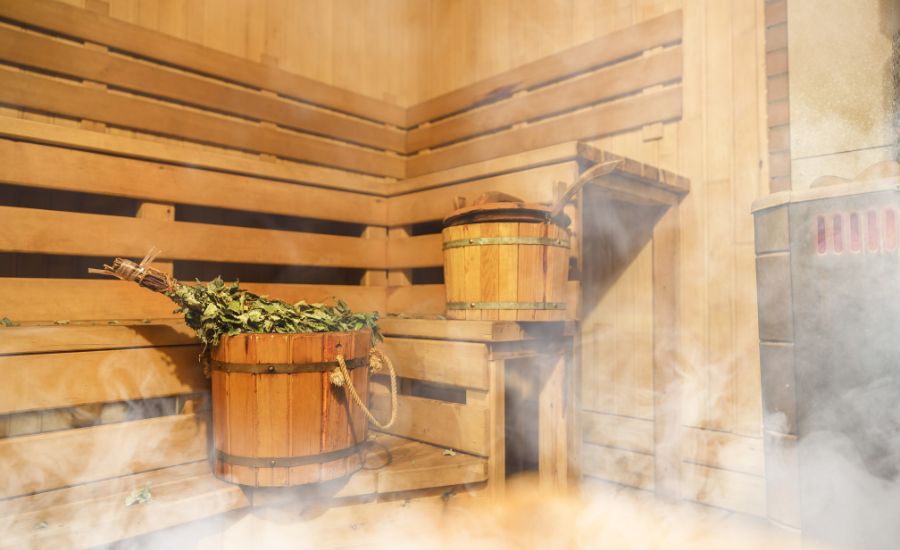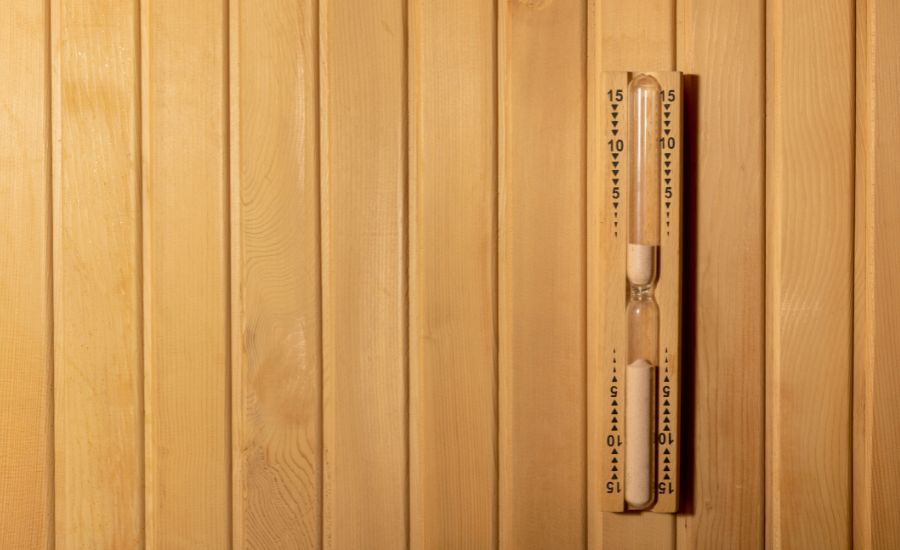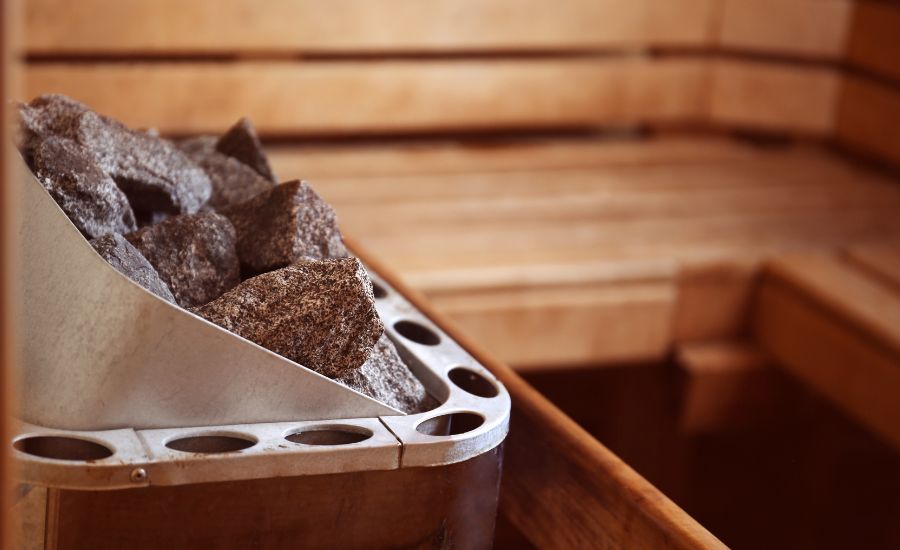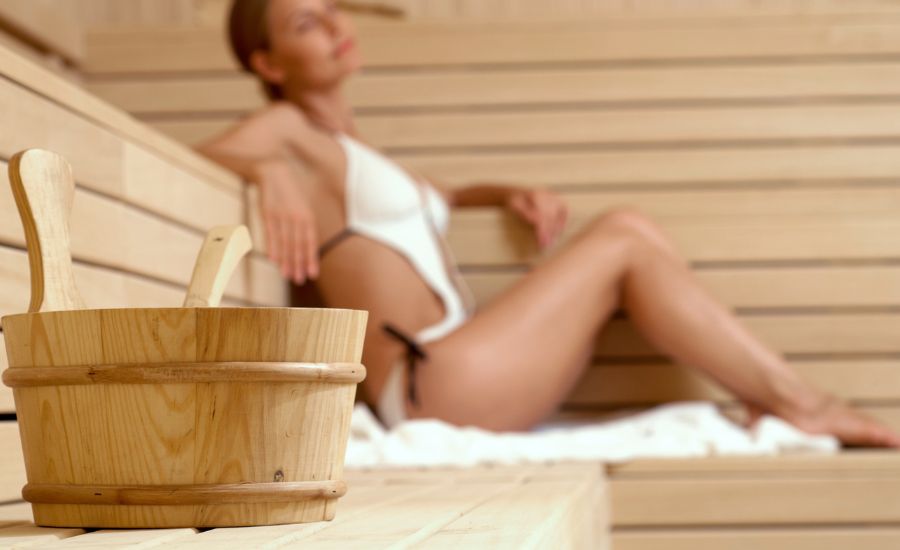How to make a sauna hotter? Saunas have been a source of relaxation, rejuvenation, and health benefits for centuries. Whether you prefer the traditional wood-burning sauna or the modern infrared sauna, one common desire is to make the sauna hotter (hotter saunas than traditional ones).
Achieving the perfect sauna temperature and creating a sauna room that radiates more heat can enhance your sauna sessions and elevate your overall experience.
In this comprehensive guide, we will explore various techniques and strategies to make your sauna hotter, regardless of the type of sauna you have.

From adjusting the sauna heater settings to maximizing the use of sauna stones, we’ll cover all the essential steps to help you reach your desired sauna temperature.
Whether you seek the ultimate relaxation or aim to reap the numerous health benefits saunas offer, this guide will ensure you get the most from your sessions in the sauna.
Understanding sauna temperature and its significance
Before we delve into the methods to make your sauna hotter, it’s essential to understand the significance of sauna temperature.
The sauna temperature directly impacts your sauna experience, affecting factors like relaxation, detoxification, and overall well-being.
Here’s what you need to know:
Temperature range: saunas typically operate within a temperature range of 150°F to 195°F (65°C to 90°C). However, personal preferences vary, and some individuals prefer even higher temperatures for a more intense session.
Desired temperature: the ideal sauna temperature can vary from person to person. Finding your needed temperature is crucial for a comfortable and effective sauna experience.
Heat therapy: higher sauna temperatures promote heat therapy, which can help relax muscles, improve blood circulation, and induce sweating to eliminate toxins from the body.
Skin health: saunas can have positive effects on skin health, promoting a healthy complexion and potentially alleviating skin conditions when used correctly.
Now that we’ve established the importance of sauna temperature, let’s explore how to make your sauna hotter and maximize the benefits of your sessions.
The efficiency of sauna heating methods
Heaters with wood-burning: sauna heaters with wood-burning offer a traditional and authentic sauna experience.
Electric heaters for sauna: electric heaters for sauna are widely used for their ease of use and precise temperature control.
Heaters with infrared emission: infrared saunas use infrared panels to heat the body directly, rather than heating the air.
Steam heaters: steam saunas, also known as wet saunas, rely on steam generators to create humidity and heat.

Adjusting sauna heater settings
The sauna heater is the heart of your sauna, responsible for generating the heat that envelops the room for the sauna.
Adjusting the sauna heat from the heater settings is the primary way to make your sauna hotter.
Here’s how you do it.
Consult the sauna thermostat
Most saunas are equipped with a thermostat sensor that allows you to set and control the temperature. Consult your sauna’s manual to understand how to adjust the thermostat.
Preheat the sauna
Turn on the sauna heater and allow it to preheat for at least 30 minutes before your sauna session.
This ensures that the room for the sauna reaches the necessary temperature.
Increase the temperature
Gradually increase the temperature on the thermostat to your preferred level. Be cautious not to make sudden temperature jumps, as it can be uncomfortable.
Monitor temperature
Regularly check the sauna thermostat during your session to ensure the sauna room remains at your desired temperature.
Use a sauna timer
Consider using a timer to maintain the sauna temperature consistently throughout your session. Some saunas have built-in timers for this purpose.

Maximizing sauna stones
Stones for the sauna play a vital role in distributing and retaining heat in the sauna. Maximizing the use of sauna stones can significantly contribute to making your sauna hotter:
Properly arrange stones for the sauna
Ensure that the stones for the sauna are evenly distributed on the sauna heater. Avoid overcrowding to allow proper airflow and heat circulation.
Increase sauna stone quantity
If your heater has space for more stones, consider adding extra stones. This increases the stone mass and helps retain heat.
Steam saunas
In steam rooms, pour water over the stones for the sauna to create steam rooms. This not only increases humidity but also raises the sauna temperature. Be cautious when adding water, as it can result in a sudden surge of steam.
Sauna with wood-burning
If you have a sauna with wood burning, control the fire to maintain a consistent and high heat level. Add wood logs as needed to sustain the suitable temperature.
Hot rocks
Some saunas use special “hot rocks” that can be heated separately and added to the sauna heater to intensify the heat.
Check if your sauna is compatible with this feature.
By maximizing the use of stones for the sauna, you can ensure that your sauna reaches and maintains the desired higher temperature, creating a room for the sauna that emits electromagnetic radiation heat.

Improving sauna insulation
The insulation of your sauna plays a crucial role in heat retention. Poor insulation can result in heat loss, making it challenging to maintain higher temperatures.
Here’s how to improve sauna insulation:
Check sauna walls and seals
Inspect the sauna walls, doors, and seals for any gaps or cracks that may allow heat to escape. Seal these areas to prevent heat loss.
Upgrade sauna materials
Consider upgrading the materials used in your sauna to those with better insulating properties. High-quality wood and insulation materials can help retain heat more effectively.
Install insulation
If your sauna lacks proper insulation, consider adding insulation material to the walls and ceiling. This can significantly improve heat retention.
Use sauna blankets
Sauna blankets or covers are designed to trap heat inside the sauna, helping to elevate the temperature.
Use them during your sauna sessions to maximize heat retention.
Enhancing ventilation
While retaining heat is crucial, proper ventilation is equally important for maintaining a comfortable and safe sauna environment.
Enhancing ventilation can help regulate the temperature of the sauna:
Control airflow
Adjust the sauna’s hot air vents to control the airflow.
Reducing airflow can help maintain higher temperatures while increasing airflow can help cool down the sauna if needed.
Introduce fresh air
It’s essential to introduce fresh air into the room for the sauna periodically.
This not only helps maintain a comfortable temperature but also ensures a continuous supply of oxygen.
Safety precautions
Always prioritize safety when using saunas.
If you ever feel uncomfortable due to excessive heat, exit the sauna immediately and allow your body to cool down.
Sauna health benefits and precautions
As you make your sauna hotter and enjoy the benefits of higher temperatures, it’s essential to be mindful of your body’s response to heat:
Stay hydrated: saunas induce sweating, leading to fluid loss. Stay hydrated by drinking water before and after your sauna session to prevent dehydration.
Monitor your body: when the sauna heats hotter, pay attention to how your body responds to the heat.
If the body temperature increases too much and you feel dizzy, nauseous, or lightheaded, exit the sauna immediately and cool down.
Sessions in hotter saunas: limit the duration of your sessions, especially in saunas hotter than traditional ones. Shorter, more intense sessions can be more effective and comfortable.
Health benefits: higher sauna temperatures can enhance the health benefits of saunas, such as improved circulation, detoxification, and relaxation.
Consult with a healthcare professional if you have specific health concerns.
Cool down: after a hot sauna session, allow your body to cool down gradually. Rest and hydrate to aid in recovery.

FAQ
Here are some of the most commonly asked questions on the topic of “how to make a sauna hotter”.
The comprehensive answers to them are also included.
Why is my sauna not getting hot enough?
Several factors can contribute to your sauna not reaching the needed temperature.
These include insufficient preheating time, issues with the sauna heater or thermostat, poor insulation, or inadequate stones for the sauna.
Ensure that you follow proper preheating procedures, check the sauna’s components for any malfunctions, and consider improving insulation and maximizing sauna stone use to achieve higher temperatures.
Does adding water to the sauna make it hotter?
Yes, adding water to the stones for the sauna can transform your conventional one into a hotter sauna.
This process, known as “löyly” in traditional saunas, creates steam and increases humidity, which, in turn, raises the perceived temperature in the sauna.
It creates a more intense heat and a unique sauna experience.
However, be cautious when adding water to prevent scalding or creating an uncomfortably high level of humidity.
Can I make my infrared sauna hotter?
Infrared saunas typically operate at lower temperatures compared to traditional saunas.
While you can’t significantly increase the temperature in an infrared sauna as you would with a traditional sauna, you can extend your sauna session for a more intense experience.
Additionally, consider positioning yourself closer to the infrared heaters to maximize the heat during your infrared sauna session.
What is the most efficient way to heat a sauna?
The most efficient way to heat a sauna is to ensure that it is properly insulated and sealed to minimize heat loss.
Preheat the sauna for at least 30 minutes before your session, evenly distribute sauna stones, and use an efficient sauna heater with an accurate thermostat.
Efficient heating methods, coupled with proper ventilation to maintain air quality, will create a comfortable and effective experience from the sauna while conserving energy.
Conclusion
Elevating the temperature in your sauna to make your sauna hotter can transform your sauna experience into the ultimate relaxation and health-enhancing ritual.
Whether you prefer conventional saunas with wood-burning heaters or the advanced technology of infrared saunas, these techniques can be applied to enhance the heat in your hot saunas.
Remember that the experience from the sauna is highly personal, and the ideal temperature may vary from person to person.
It’s essential to listen to your body and adjust the temperature accordingly.
With the right adjustments to your heaters, proper use of sauna stones, improved insulation, and ventilation, you can create a sauna environment that offers the heat therapy and relaxation you desire.
By following these steps, you can make your sauna hotter and enjoy the full range of benefits that saunas have to offer.

